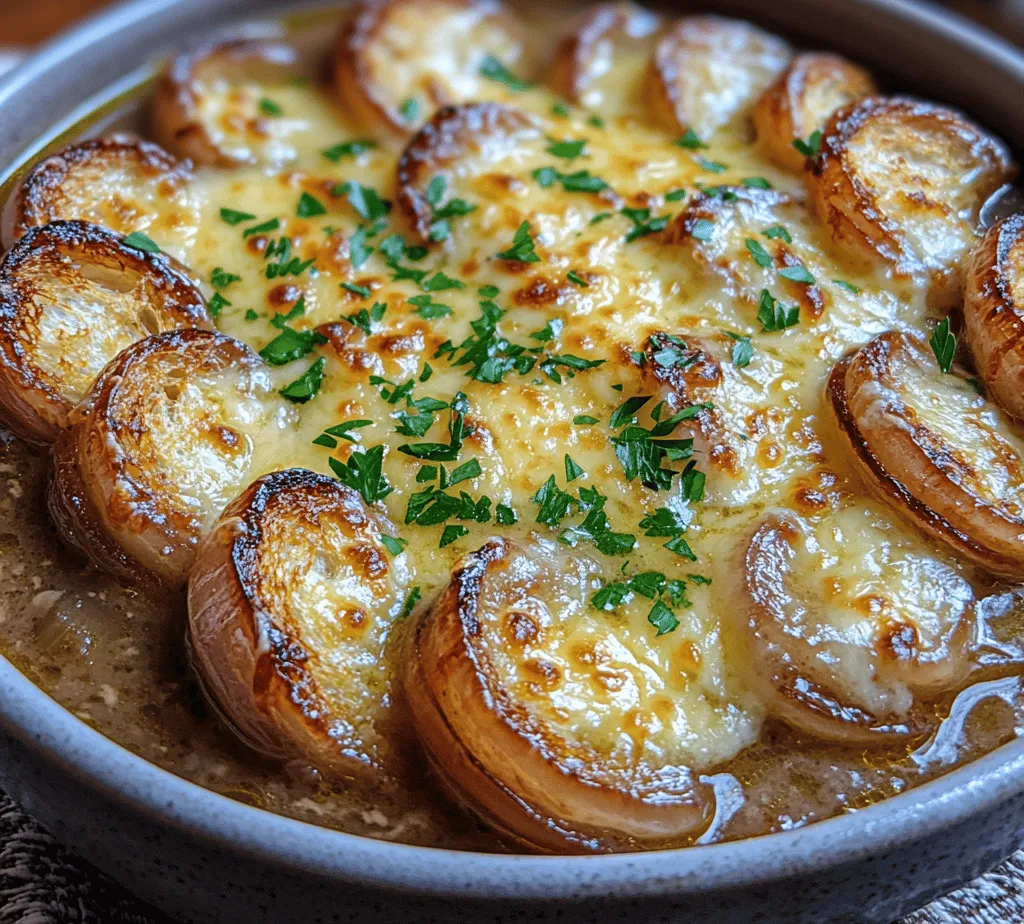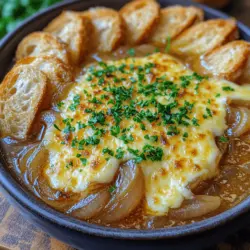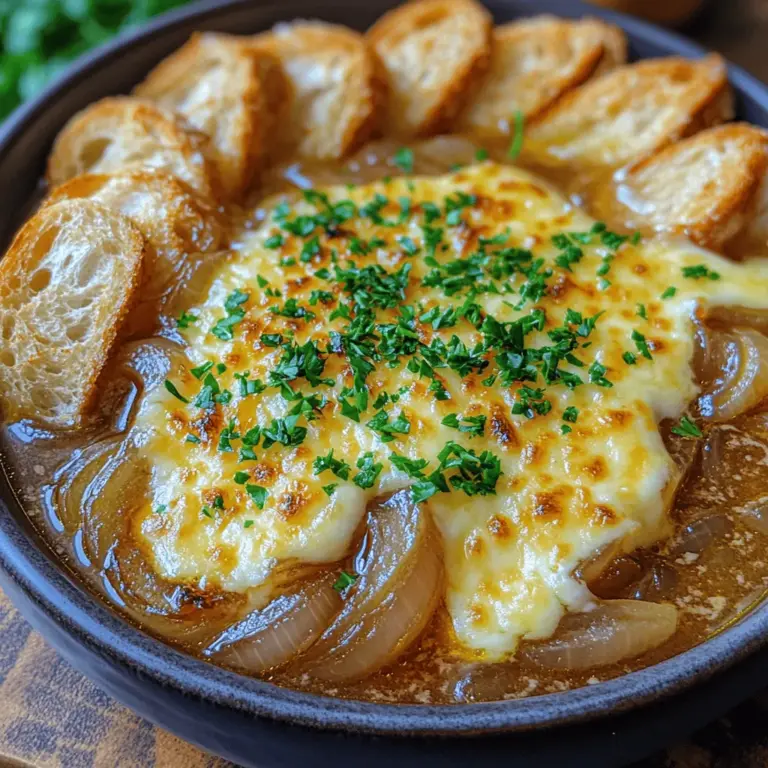Introduction
Classic French onion soup is more than just a dish; it’s a warm embrace on a chilly day, a taste of history in each spoonful, and a testament to the brilliance of simple ingredients transformed through careful preparation. Renowned for its deep, rich flavor and elegant presentation, this soup has earned its place as a beloved staple in homes and bistros across the globe. As you delve into a bowl of this savory delight, you’re not only treating your palate to a symphony of flavors but also partaking in centuries of culinary tradition.
At the heart of French onion soup are its key ingredients: sweet yellow onions, robust beef stock, a splash of white wine, and a generous topping of Gruyère cheese. These elements come together to create a dish that is both comforting and sophisticated. Through caramelization, the onions develop a sweetness that balances beautifully with the richness of the broth and the nutty flavor of the cheese. As we explore this classic recipe, you’ll discover how each ingredient plays a vital role in crafting a soup that is truly unforgettable.
Understanding French Onion Soup
The origins of French onion soup can be traced back to ancient Rome, where a similar dish made from onions, leeks, and other ingredients was consumed. However, its transformation into the beloved soup we know today began in France, particularly during the 18th century. Initially considered a humble peasant dish, it was made using simple ingredients that were readily available. The original recipes often called for just onions, water, and stale bread—ingredients that were often overlooked in the grander schemes of French cuisine.
As the culinary world evolved, so did French onion soup. It became a gourmet staple, especially in the bustling bistros of Paris, where it was celebrated for its comforting qualities and rich flavors. The dish enjoyed a renaissance in the 19th century, gaining prominence among the upper classes and eventually finding its way onto restaurant menus worldwide. This transition marked its evolution from a rustic dish to an emblem of French culture and gastronomy.
Today, French onion soup is cherished not only in France but also in various forms around the world. In the United States, for instance, it is often adapted with different types of cheeses or stocks, and some recipes even incorporate additional ingredients like garlic or herbs. Despite these variations, the essence of the classic recipe remains—a deeply flavorful broth, caramelized onions, and a crust of melted cheese that tantalizes the taste buds.
Ingredients Breakdown
Creating the perfect bowl of classic French onion soup requires careful selection and preparation of ingredients. Each component contributes uniquely to the depth of flavor and overall success of the dish. Here’s a closer look at the essential ingredients:
Yellow Onions
The star of this dish, yellow onions, are known for their natural sweetness, which intensifies beautifully when caramelized. This process transforms their sharpness into a rich, sweet flavor that forms the foundation of the soup. While other onion varieties like red or white can be used, yellow onions are preferred for their balance of sweetness and savory notes, making them ideal for this classic recipe.
Unsalted Butter and Olive Oil
The combination of unsalted butter and olive oil serves multiple purposes in the cooking process. The butter adds a rich, creamy texture and enhances the overall mouthfeel of the soup, while the olive oil offers a slightly fruity note that complements the onions. This duo is essential for sautéing the onions to achieve that perfect caramelization without burning.
Beef Stock
Using high-quality beef stock is crucial for developing the soup’s depth of flavor. The stock provides a hearty, umami-rich base that enriches the overall taste profile. For best results, opt for homemade stock or a reputable store-bought variety that is low in sodium. This allows you to control the seasoning as you build the flavors in your soup.
Wine
A splash of dry white wine is an important addition to French onion soup, as it contributes acidity and complexity to the broth. The wine helps deglaze the pan, lifting any caramelized bits from the bottom and incorporating them into the soup for an added layer of flavor. Choose a wine that you enjoy drinking, as its flavor will be present in the final dish.
Gruyère Cheese
Gruyère cheese is the quintessential topping for French onion soup, known for its excellent melting properties and nutty flavor. When broiled until golden and bubbly, it forms a delicious crust that enhances the soup’s comforting qualities. If Gruyère is not available, Emmental or a combination of Swiss cheeses can be used as substitutes, though the unique taste of Gruyère is hard to replicate.
Herbs and Seasonings
Finally, a selection of herbs and seasonings rounds out the soup’s flavor profile. Fresh thyme is a classic choice, adding a fragrant earthiness that complements the sweetness of the onions. A bay leaf can also be added during the simmering process for additional depth. Season sparingly with salt and pepper, tasting as you go to ensure the flavors are balanced.
Preparation Steps for Classic French Onion Soup
Now that you have a solid understanding of the ingredients, let’s embark on the journey of preparing classic French onion soup. The process may seem lengthy, but each step is essential in building the rich, layered flavors that define this iconic dish. Follow these detailed instructions to create a soup that will impress family and friends alike.
Step 1: Slice the Onions
Start by peeling and slicing the yellow onions. Aim for thin, even slices, as this will ensure uniform cooking and caramelization. A mandoline slicer can be helpful for achieving consistent thickness; however, a sharp chef’s knife will work just as well. You should aim for about 4 to 5 large onions, which will yield the ideal quantity for a hearty soup.
Step 2: Sauté the Onions
In a large, heavy-bottomed pot or Dutch oven, heat a combination of unsalted butter and olive oil over medium heat. Once the butter has melted and the mixture is shimmering, add the sliced onions. Stir to coat them in the fat, then reduce the heat to medium-low. This low and slow cooking process is vital for caramelizing the onions without burning them.
Cook the onions, stirring occasionally, for about 30 to 40 minutes. The goal is to achieve a deep golden brown color, which indicates that they are perfectly caramelized. Depending on your stove, you may need to adjust the heat to prevent them from sticking or burning. Patience is key here; the longer they cook, the sweeter and more flavorful they will become.
Step 3: Deglaze the Pot
Once the onions are beautifully caramelized, it’s time to deglaze the pot. Increase the heat to medium-high and pour in the dry white wine. Use a wooden spoon to scrape up any browned bits from the bottom of the pot—they hold a wealth of flavor that you want to incorporate into the soup. Allow the wine to cook down for a few minutes until it has mostly evaporated, leaving behind a rich essence.
Step 4: Add the Stock and Seasonings
Next, pour in the beef stock, stirring to combine. Add fresh thyme and a bay leaf to the pot, which will infuse the soup with aromatic flavors as it simmers. Bring the mixture to a gentle boil, then reduce the heat to low and let it simmer for about 30 minutes. This step allows the flavors to meld and deepen, creating a beautifully complex broth.
Step 5: Taste and Adjust Seasonings
After simmering, taste the soup and adjust the seasonings to your liking. You may want to add salt and freshly cracked black pepper to enhance the flavors. Remember, the quality of your stock will influence the final taste, so don’t hesitate to make adjustments based on how rich or savory the broth is.
Step 6: Prepare the Cheese Topping
While the soup is simmering, prepare the cheese topping. Preheat your broiler to high. Slice a baguette into thick rounds and toast them lightly until golden brown on both sides. This step ensures that they hold up well when topped with cheese and broiled.
Step 7: Assemble and Broil
To serve, ladle the hot soup into oven-safe bowls, placing a toasted baguette slice on top of each bowl. Generously sprinkle grated Gruyère cheese over the bread, ensuring even coverage. Place the bowls on a baking sheet and broil in the preheated oven until the cheese is melted, bubbly, and golden brown. Keep a close eye on the broiler, as this can happen quickly.
With these steps, you’re well on your way to serving up an exquisite bowl of classic French onion soup. Each ingredient and preparation technique contributes to a dish that is not only delicious but also steeped in history and comfort, making it a true culinary treasure.

Cooking the Onions
The heart and soul of classic French onion soup lie in the caramelization of onions. This process transforms the sharp, raw flavor of onions into a sweet, rich foundation for the soup, contributing depth and complexity. Caramelization occurs when the natural sugars in the onions break down and brown due to heat. It’s important not to rush this step; medium to low heat is essential to ensure even cooking and to prevent burning. Stirring the onions frequently also helps release moisture and promotes even browning.
Aim for a golden-brown color, which signifies that the sugars have fully developed. This process can take anywhere from 30 to 45 minutes, so patience is key. The result will be a deeply flavored caramelized onion base that forms the backbone of your soup, ensuring each spoonful is bursting with flavor.
Adding Garlic and Flour
Once the onions are perfectly caramelized, it’s time to build a flavorful base by adding garlic and flour. Garlic not only enhances the overall flavor profile but also adds a fragrant aroma that complements the sweetness of the onions. Typically, you’ll want to add minced garlic to the pot one to two minutes before proceeding to the next step, allowing it to soften without burning.
The addition of flour is crucial for thickening the soup slightly and providing a smooth texture. Sprinkle the flour over the caramelized onions and garlic, stirring well to combine. Cook this mixture for about two minutes to remove the raw flour taste, ensuring it becomes integrated into the soup’s foundation.
Deglazing
Next comes the deglazing step, which is essential for capturing all the delicious, browned bits stuck to the bottom of the pot, known as fond. This is where a lot of the flavor resides. Pour in a splash of dry white wine or sherry, scraping the bottom of the pot with a wooden spoon to release these flavorful morsels. As the wine simmers, it will reduce, intensifying the flavor and adding a layer of acidity that balances the sweetness of the onions. Allow the mixture to simmer for a few minutes until the liquid has reduced by half.
Adding Broth and Herbs
With the fond nicely incorporated, it’s time to add the broth and herbs. Pour in a rich beef or vegetable broth, which will provide the soup with its hearty essence. Bring the mixture to a gentle simmer, and add fresh herbs such as thyme and bay leaves to enhance the flavor. Simmer the soup for at least 30 minutes to allow the flavors to meld together beautifully.
During this time, the herbs will infuse the broth with their aromatic qualities, while the onions will continue to soften and deepen in flavor. Remember to taste and adjust seasoning with salt and freshly cracked black pepper, ensuring that the broth is balanced and flavorful.
Preparing the Baguette
While the soup simmers, prepare your baguette for that iconic topping. Choose a crusty French baguette, as its robust texture holds up well against the soup’s warmth. Slice the baguette into thick pieces, about one inch each. Toasting the bread is essential; it adds a delightful crunch that contrasts with the rich, silky soup. You can toast the slices in a preheated oven at 400°F (200°C) for about 10 minutes, or until they are golden and crispy. For an added layer of flavor, consider brushing the bread with a little olive oil or butter before toasting.
Assembling the Soup
Now that you have your soup and toasted baguette ready, it’s time to assemble the dish. Ladle the hot soup into oven-safe bowls, filling them about three-quarters full. Place a slice or two of the toasted baguette on top of the soup, ensuring it covers the surface well. The bread will absorb some of the soup, adding to the overall texture and flavor.
Next, generously sprinkle shredded Gruyère cheese over the bread. Gruyère is traditional in French onion soup, known for its nutty flavor and excellent melting properties. For a more complex flavor, consider mixing it with a bit of Emmental or even a sharp cheddar. The cheese layer should be thick enough to create that coveted cheesy crust.
Broiling
The final step to achieving the perfect cheese crust involves broiling. Place the assembled bowls onto a baking sheet for easy handling and transfer them to the oven. Broil on high for about 3 to 5 minutes, keeping a close eye to prevent burning. The cheese should bubble and turn a lovely golden brown. Once achieved, carefully remove the bowls from the oven, as they will be extremely hot.
Serving Suggestions
Classic French onion soup is best served piping hot, and the presentation can elevate the dining experience. Use oven-safe bowls that are deep enough to hold the soup and the cheese without overflowing. For a complete meal, pair the soup with a simple mixed green salad dressed in a light vinaigrette to balance the richness of the soup. A slice of crusty bread on the side is also a perfect complement, allowing diners to soak up any remaining broth.
When it comes to beverages, a light, crisp white wine such as a Sauvignon Blanc or a dry Riesling pairs beautifully with the dish, enhancing the flavors without overpowering them. If you prefer red, a light-bodied Pinot Noir can also work well, providing a nice contrast to the soup’s richness.
Nutritional Information
A serving of classic French onion soup typically contains approximately 300-400 calories, depending on the ingredients used and portion size. The nutritional content includes essential vitamins and minerals derived from the onions, which are rich in Vitamin C, B vitamins, and antioxidants. The cheese adds protein and calcium, contributing to a balanced meal.
For those with dietary restrictions, consider using gluten-free baguettes or bread alternatives to accommodate gluten sensitivities. Additionally, cheese lovers might experiment with dairy-free cheese options that melt well, ensuring everyone can enjoy this comforting dish.
Conclusion
Classic French onion soup embodies comfort and warmth, making it a beloved dish for many. The careful process of caramelizing onions, layering flavors, and achieving that perfect cheesy crust creates a bowl of pure indulgence. Each step is essential to crafting a soup that not only warms the body but also nourishes the soul.
Encouraging readers to try making this recipe at home allows them to experience the rich flavors and comforting aroma firsthand. As you gather around the table, sharing bowls of this timeless dish, you’ll find that classic French onion soup continues to bring people together, creating moments of joy and connection over warm, deliciousness.


